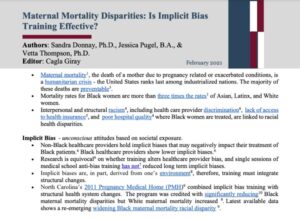Policing in Schools
Madison Gerdes
- 51% of majority Black high schools have a police presence.1
- Students at schools with police officers are arrested at a rate that is almost 5 times the rate of students at schools without a police presence.11

Police officers are present in 42% of all high schools and 51% of high schools with a student population that is more than 75% Black and Latino1. School resource officers, or SROs, are defined by the Omnibus Crime Control and Safe Streets Act of 1968 as “a career law enforcement officer with sworn authority who is deployed by an employing police department or agency in a community-oriented policing assignment to work in collaboration with one or more schools”2. Collaborations between police departments and schools to improve school safety began in the 1950s with a pilot program in Flint, Michigan3. This program attempted to prevent juvenile delinquency both during and after school by teaching students about law enforcement and identifying potential deviant students3. Police presence in schools boomed in the 1990 prompting concerns about a perceived rise in juvenile delinquency. 4 The consequence of this increased presence led to the rapid implementation of zero tolerance policies in schools.4
School resource officers often use exclusionary discipline tactics to deal with criminal and non-criminal misbehavior in schools5. Exclusionary discipline, defined as any disciplinary action that involves removing a student from their classroom or learning setting, has been associated with a number of negative student outcomes including falling behind peers in classes6, scoring lower on standardized tests7, and missing important class instructional time8. Further, schools that utilize exclusionary discipline have worse outcomes on standardized tests9 and have higher dropout and lower graduation rates10. Additionally, SRO presence increases student contact with the criminal justice system and bolsters the school to prison pipeline. Schools with SROs have a rate of student arrest that is almost 5 times the arrest rate of students at schools without a police presence. 11. Black students disproportionately bear the burden of these negative impacts of SRO presence. Schools with higher percentages of Black students are more likely to employ zero-tolerance policies, and Black students are 2.3x more likely to be referred to law enforcement or arrested in school compared to White students1.
References
- U.S. Department of Education. (2019). 2015-16 Civil Rights Data Collection: School Climate and Safety. U.S. Department of Education, Office for Civil Rights, May, 1–18.
- Omnibus crime control and safe streets act of 1968, S. 917. (1968) (testimony of United States).
- Noble, K. A. (2017). Policing the Hallways: The Origins of School-Police Partnerships in Twentieth Century American Urban Public Schools. University of Florida.
- Price, P. (2009). When is a Police Officer an Officer of the Law?: The Status of Police Officers in Schools. Journal of Criminal Law and Criminology, 99(2), 541–570.
- Fisher, B. W., & Hennessy, E. A. (2015). School Resource Officers and Exclusionary Discipline in U.S. High Schools: A Systematic Review and Meta-analysis. Adolescent Research Review, 1(3), 217–233. https://doi.org/10.1007/s40894-015-0006-8
- Arcia, E. (2006). Achievement and Enrollment Status of Suspended Students: Outcomes in a Large, Multicultural School District. Education and Urban Society, 38(3), 359–369.
- Kupchik, A. (2010). Homeroom security: School discipline in an age of fear. New York University Press.
- Raffaele Mendez, L. M. (2003). Predictors of suspension and negative school outcomes: A longitudinal investigation. In New Directions for Youth Development (pp. 17–33). https://doi.org/10.1002/yd.52
- Raffaele Mendez, L. M., Knoff, H. M., & Ferron, J. M. (2002). School demographic variables and out-of-school suspension rates: A quantitative and qualitative analysis of a large, ethnically diverse school district. Psychology in the Schools, 39, 269–277.
- Christle, C., Jovilette, K., & Nelson, C. M. (2005). Breaking the School to Prison Pipeline: Identifying School Risk and Protective Factors for Youth Delinquency. Exceptionality, 13(2), 69–88.
- Theriot, M. T. (2016). The Impact of School Resource Officer Interaction on Students’ Feelings About School and School Police. Crime & Delinquency, 62(4), 446.


